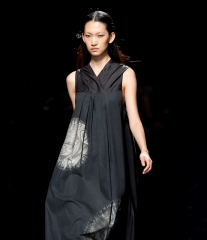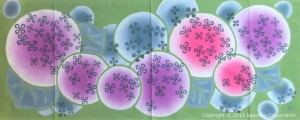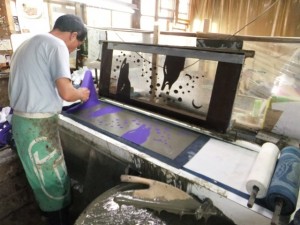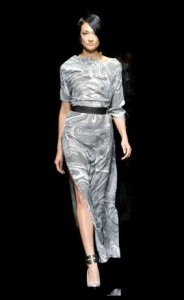
araisara was originally published online on Ethical Fashion Japan in April 2012, and is the first of a series of three articles about the label. It is edited and republished with permission.
| 「時」 今秒日時過代年分月世未 |
toki (A Moment) |
| 現在は点 過去は線 未来は形 点からなる線 線からなる形 点がなくては線ができず 線がなくては形ができず 点となる時 線となる時 形となる時 全ては繋がる一つの時 |
The present, a dot. The past, a line. The future, a shape. A dot becomes a line. A line a shape. Without a dot, a line can’t be created. Without a line, we can’t create a shape. A dot in a moment. A line in a moment. A shape in a moment. Everything linked together, in a single moment. |
Author: Ethical Fashion Japan, Twitter: @EthicalJP
Editing: Shirahime
Translation of Poem: Shirahime
Each moment is a dot. Dots then create a line, which will eventually form a shape. This was Araisara‘s original collection theme as well as brand concept. Six years since the launch of Araisara‘s first collection, this principle still inspires the brand and makes the designer feel that she needs to cherish every moment of each day.

This dyer still follows the traditional recipe exactly he was handed it down from his teacher, using water from the Tagawa River and as dye stuffs, wild flowers picked from around the atelier and naturally air-dried with sunshine and wind. The designer could feel the soul of the artisan, how he cherished the ancient ingenuity of the creations.
In Miya-zome, the colours come out differently according to how the sun has shone and the condition of the soil and flowers. When Araisara saw some of the 15-meter long Miyazome-dyeed textiles in various colours blowing in the wind, it was like the pieces were dancing with light, joyful steps.

While washing a newly dyed piece of cloth, he said to the designer,
There was once a time when Miyazome-dyes were so famous and popular that Utsunomiya was synonymous with them. But now, what people would have in mind when they hear the name Utsunomiya are Chinese dumplings. Even the locals don’t know of Miyazome-dyes anymore. No wonder they the whole art is dying out.
Finding this serene, natural place and the artisan, Araisara realized what it means to live in nature; she also realized that she had to tell everyone about what society, humanity was about to loose, have lost already, or are on the way of losing.
As a clothes designer, Araisara had some understanding of how the old techniques are gradually fading away, but she had had her eyes shut, not recognizing how critical the situation already was, and in this way taking the easy way out by resigning herself to accepting this crisis would lead to the extinction of beautiful traditional techniques.
On her way back from Utsunomiya to Tokyo, she then firmly resolved to follow her heart: She must pass on the wonderful traditional ways to future generations through her clothes, and tell as many people as possible about the beauty of Asian scenery, nature, and culture, and the Asian soul. In order to do that, the first step was about taking decisions: What must and can preserved, and what will have to change, innovate.

Araisara decided to carry over into her new to be launched prêt-a-porter line.
With the contribution of great artisans, araisara – the fashion label – presented its first collection during Japan Fashion Week in March 2009 with pieces featuring Miyazome-dyes.
After the runway show, which received much applause, people said to her things such as ‘It was great!‘, and ‘It touched my heart, or ‘Watching the models walk brought tears to my eyes.’
As the designer heard these glowing reviews, she remembered the days with artisan, when the dots she had been tracing connected into a line, and these lines made her collection. She was now sure she could pass on his techniques to future generations. In fact, by now some local schools in Utsunomiya have even started to teach for Miyazome-dyes to their students. Some younger people have started to visit the factory, and – most importantly – a few started to work as apprentices after seeing the runway collection.
Araisara says that she would like to continue following her aim: to carefully draw each dot of the moment, and trace them to create new collections.
She things that it would be exciting if this article became a dot for you, the reader and would lead you to a new line for a new creation.
About Miyazome-dyeing
This dye techniques dates from the late Edo Period, when Mooka cotton (cotton produced in Mooka City, Ibaraki Prefecture, east of Utsunomiya City) became popular. Many artisans gathered around the Tagawa-river, which flows between Mooka City and Utsunomiya City, to dye the Mooka cotton textiles, which became known as Miyazome-dye. Dyed fabric produced in the Tagawa-river region is generically called Miyazome-dye.
Later, the artisans developed a method called chu-sen (a method of dyeing using mud to make a mold in the shape you want to create and then pouring the dye in) and started to dye the textiles with artistic designs.
The peculiarity of these dyeing techniques is, that the design comes out just as beautiful on the front andas on back, to the extent that it could be said that there is no front or back. The dye is naturally dried on sunny days, preventing the filaments from being destroyed and making the fabric well ventilated.
Finally, the colour shades evolve over time with use, and in that sense each pieces is not only your very own unique design, there is also a ‘new garment’ ready to be be showed with every use. .

